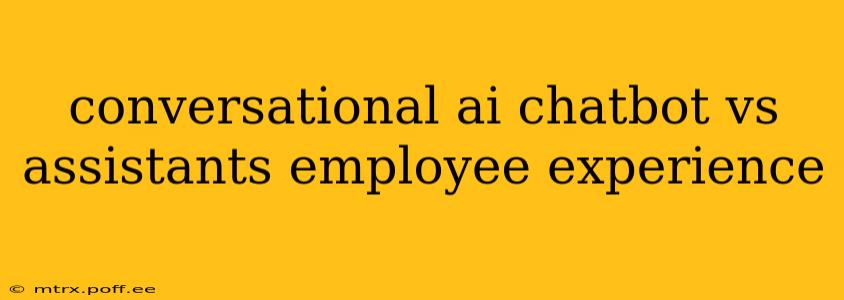The modern workplace is undergoing a significant transformation, driven largely by advancements in artificial intelligence (AI). One area experiencing a dramatic shift is employee support and communication, with the rise of conversational AI chatbots challenging the traditional role of human assistants. This article delves into the comparative strengths and weaknesses of both, exploring their impact on employee experience and the future of workplace support.
What are Conversational AI Chatbots?
Conversational AI chatbots are computer programs designed to simulate human conversation. They leverage natural language processing (NLP) and machine learning (ML) to understand and respond to employee queries, requests, and concerns. These chatbots can handle a wide range of tasks, from answering frequently asked questions (FAQs) about company policies to providing technical support and scheduling meetings. The best ones are continuously learning and improving their responses based on interactions with employees.
What is the Role of Human Assistants in the Workplace?
Human assistants play a vital role in supporting employees and ensuring smooth daily operations. Their responsibilities are multifaceted, encompassing administrative tasks, communication management, problem-solving, and offering personalized support. Human interaction and empathy remain core competencies that are difficult for AI to replicate fully.
Conversational AI Chatbots: Advantages for Employee Experience
- 24/7 Availability: Unlike human assistants, chatbots are available around the clock, providing instant support whenever employees need it, regardless of time zones or holidays. This constant availability significantly improves response times and reduces employee frustration.
- Increased Efficiency: Chatbots can handle a large volume of routine queries simultaneously, freeing up human assistants to focus on more complex tasks that require human judgment and emotional intelligence. This increased efficiency leads to improved productivity across the organization.
- Scalability and Cost-Effectiveness: Deploying and scaling conversational AI chatbots is typically more cost-effective than hiring and training a large team of human assistants. This is especially beneficial for growing companies or those with geographically dispersed workforces.
- Consistency and Accuracy: Chatbots deliver consistent and accurate information based on pre-programmed knowledge bases. This minimizes the risk of human error and ensures employees receive reliable information every time.
- Improved Employee Self-Service: Empowering employees to find answers independently through self-service options fosters a sense of autonomy and reduces reliance on human intervention for simple tasks.
Human Assistants: Advantages for Employee Experience
- Empathy and Emotional Intelligence: Human assistants excel at understanding nuanced situations, offering empathy, and providing personalized support that addresses individual employee needs. This human touch is crucial in dealing with sensitive or complex issues.
- Complex Problem-Solving: While chatbots can handle routine tasks, human assistants possess critical thinking skills and experience to solve intricate problems that require creative solutions and in-depth knowledge.
- Building Relationships and Company Culture: Human interaction plays a crucial role in fostering positive relationships and building a strong company culture. Human assistants can contribute significantly to this by creating a welcoming and supportive environment.
- Adaptability and Flexibility: Human assistants can adapt to unexpected situations and adjust their approach based on the specific needs of each employee. They are more flexible and resourceful in handling unforeseen circumstances.
- Personalized Guidance and Mentoring: Human assistants can provide personalized guidance, mentorship, and career development support, fostering employee growth and loyalty.
Which is Better for Employee Experience? The Hybrid Approach
The ideal solution is not an either/or proposition. The most effective approach leverages the strengths of both conversational AI chatbots and human assistants in a hybrid model. Chatbots handle routine tasks and FAQs, improving efficiency and reducing wait times. Human assistants focus on complex issues, fostering relationships, and providing personalized support where AI falls short. This synergistic approach delivers a superior employee experience, combining the speed and efficiency of AI with the empathy and problem-solving abilities of humans.
How to Successfully Implement a Hybrid Model:
- Clearly define roles and responsibilities: Establish a clear division of labor between chatbots and human assistants to avoid confusion and duplication of effort.
- Invest in robust chatbot technology: Select a platform with advanced NLP capabilities to ensure accurate and efficient responses.
- Provide comprehensive training: Train employees on how to effectively use the chatbot system and when to escalate issues to a human assistant.
- Gather regular feedback: Continuously monitor employee feedback and use it to refine the chatbot's functionality and improve the overall employee experience.
- Prioritize employee needs: Always prioritize the needs and well-being of employees when making decisions about technology and support systems.
What are the Potential Challenges of Implementing AI Chatbots?
- Data Privacy and Security: Protecting employee data is crucial. Robust security measures are essential to prevent breaches and maintain compliance with relevant regulations.
- Integration with Existing Systems: Integrating chatbots with existing HR systems and other workplace technologies can be complex and require careful planning.
- Maintaining Accuracy and Up-to-Date Information: The chatbot's knowledge base must be regularly updated to ensure it provides accurate and relevant information.
- Over-reliance on Automation: Striking the right balance between automation and human interaction is essential. Over-reliance on chatbots can lead to a less personalized and human-centric experience.
By carefully considering these factors and implementing a well-planned hybrid approach, organizations can leverage the power of conversational AI to significantly improve the employee experience, fostering a more efficient, supportive, and engaging workplace.
